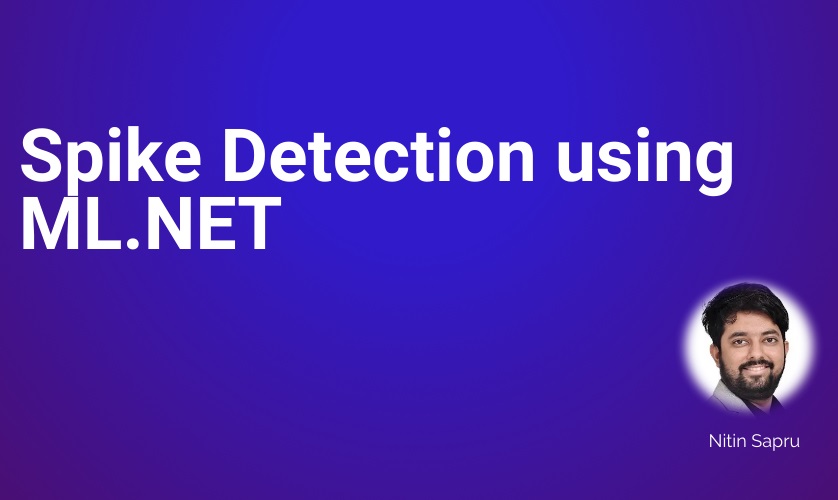Unveiling the Power of ML .NET: Spike Detection in Product Cost Time Series Data
 Nitin Sapru
Nitin Sapru
In the fast-paced world of business, staying ahead of the curve requires timely and insightful decision-making. One crucial aspect of this decision-making process is the ability to detect anomalies or spikes in data, especially when it comes to product cost time series data. In this blog post, we'll delve into the fascinating realm of machine learning using ML .NET to identify and analyze spikes in product cost time series data, helping businesses make informed decisions and mitigate potential risks.
Understanding the Problem:
Product cost time series data is a goldmine of information for businesses, providing valuable insights into pricing trends, cost fluctuations, and potential anomalies. Detecting spikes in this data is essential for identifying irregularities that may impact profitability, supplier relationships, or overall business operations.
The ML .NET Advantage:
ML .NET, an open-source and cross-platform machine learning framework developed by Microsoft, empowers developers to integrate machine learning into their .NET applications seamlessly. Leveraging ML .NET's capabilities for spike detection in product cost time series data not only simplifies the process but also ensures reliability and scalability.
Getting Started with ML .NET:
Data Preparation:
Begin by collecting and cleaning historical product cost time series data.
Split the data into training and testing sets to train and evaluate the model effectively.
Selecting a Model:
- ML .NET provides various algorithms for time series analysis. Choose a suitable algorithm for spike detection, such as the Seasonal-Trend decomposition using LOESS (STL) algorithm.
Feature Engineering:
- Enhance the dataset by incorporating relevant features, considering factors like seasonality and trends that may impact product cost.
Training the Model:
Utilize the ML .NET framework to train the selected model on the prepared dataset.
Adjust hyperparameters and experiment with different configurations to optimize model performance.
Evaluation:
Assess the model's accuracy using the testing dataset.
Fine-tune the model to improve its spike detection capabilities.
Implementing Spike Detection:
Integration with .NET Applications:
Incorporate the trained model into your .NET applications using ML .NET's easy-to-use APIs.
Ensure seamless interaction with product cost time series data within your existing business applications.
Real-Time Monitoring:
Implement a real-time monitoring system to continuously analyze incoming product cost data for potential spikes.
Set up alerts or notifications for immediate response to identified anomalies.
Step 1: Install ML .NET NuGet Packages
dotnet add package Microsoft.ML
dotnet add package Microsoft.ML.TimeSeries
Step 2: Load and Prepare Data
using Microsoft.ML;
using Microsoft.ML.Data;
public class ProductCostData
{
[LoadColumn(0)]
public DateTime Timestamp { get; set; }
[LoadColumn(1)]
public float Cost { get; set; }
}
public class ProductCostPrediction
{
[VectorType(2)]
public double[] Prediction { get; set; }
}
var context = new MLContext();
// Load and prepare the data
var data = context.Data.LoadFromTextFile<ProductCostData>("path/to/your/data.csv", separatorChar: ',');
// There are other ways you can plug into your data as well like:
// Inmemory enumeration
// Using SQL DB providers
// You can also create your own implementation for a DB provider
Step 3: Define the Model
var pipeline = context.Transforms.DetectSpikeBySsa(outputColumnName: "Prediction", inputColumnName: "Cost", confidence: 95.0, pvalueHistoryLength: 30)
.Append(context.Transforms.CopyColumns("Prediction", "Score"));
Step 4: Train the Model
var model = pipeline.Fit(data);
Step 5: Make Predictions
var predictions = model.Transform(data);
var predictionEngine = context.Model.CreatePredictionEngine<ProductCostData, ProductCostPrediction>(model);
var prediction = predictionEngine.Predict(new ProductCostData { Timestamp = DateTime.Now, Cost = 150.0f });
Console.WriteLine($"Prediction: {prediction.Prediction[0]}, Score: {prediction.Prediction[1]}");
Step 6: Integrate with Real-Time Monitoring
// Continuously monitor incoming data
while (true)
{
// Get new data point (replace with actual data retrieval logic)
var newDataPoint = new ProductCostData { Timestamp = DateTime.Now, Cost = GetNewCost() };
// Make a prediction
var result = predictionEngine.Predict(newDataPoint);
// Check if spike is detected
if (result.Prediction[0] == 1)
{
Console.WriteLine("Spike detected! Take appropriate action.");
}
// Add the new data point to the dataset
// Update the model periodically for continuous learning
// (Add logic based on your application's requirements)
data = context.Data.Append(data, newDataPoint);
model = pipeline.Fit(data);
}
Benefits of ML .NET over other machine learning services:
Integration with .NET Ecosystem:
- ML .NET seamlessly integrates with the .NET ecosystem, making it easy for developers familiar with C# and .NET to incorporate machine learning into their applications. This integration simplifies the development process and allows for efficient collaboration across different parts of the software stack.
Open Source and Cross-Platform:
- It is an open-source framework, providing transparency and flexibility. Developers can access the source code, contribute to the community, and customize the framework to suit their specific needs. Additionally, it is cross-platform, supporting Windows, Linux, and macOS, allowing developers to deploy their machine learning models across various environments.
Ease of Use:
- It is designed to be user-friendly and accessible to developers with varying levels of expertise in machine learning. Its high-level APIs and intuitive syntax make it easy to implement common machine learning tasks, such as training models, making predictions, and evaluating performance.
Versatility in Model Types:
- It supports a wide range of machine learning model types, including classification, regression, clustering, recommendation, and anomaly detection. This versatility allows developers to choose the most suitable model for their specific use case without being constrained to a particular type.
Scalability:
- It is designed for scalability, allowing developers to deploy models in a variety of scenarios, from small-scale applications to large-scale, production-ready systems. This scalability is essential for businesses looking to leverage machine learning across different parts of their operations.
Interoperability:
- It supports interoperability with popular machine learning frameworks such as TensorFlow and ONNX (Open Neural Network Exchange). This allows developers to use pre-trained models from these frameworks within ML .NET applications and vice versa, providing flexibility in model selection and deployment.
Integration with Azure:
- It integrates seamlessly with Microsoft Azure, enabling developers to leverage cloud-based services for tasks such as model training, deployment, and monitoring. This integration facilitates the development of end-to-end machine learning solutions that can take advantage of cloud resources and scalability.
Community and Support:
- As an open-source project backed by Microsoft, it benefits from a vibrant community of developers and contributors. This community provides support, shares best practices, and contributes to the continuous improvement of the framework.
Faster training & better predictions:
Conclusion:
In conclusion, the integration of ML .NET for spike detection in product cost time series data opens up new possibilities for businesses striving to stay competitive in today's dynamic markets. By harnessing the power of machine learning, organizations can transform raw data into actionable insights, making informed decisions that drive success.
The journey of implementing ML .NET spike detection is an exciting one, offering a valuable tool for businesses seeking to navigate the complexities of product cost fluctuations and ensure a prosperous future.
Subscribe to my newsletter
Read articles from Nitin Sapru directly inside your inbox. Subscribe to the newsletter, and don't miss out.
Written by

Nitin Sapru
Nitin Sapru
Experienced senior software developer & designer with a demonstrated history of working in the information technology and services industry. Skilled in C#, Dotnet Core, Kubernetes, Microservices, Azure DevOps, GitHub Actions, Microsoft Azure PaaS/IaaS, SQL & No-SQL Databases, JavaScript . Extensive experience in designing & developing complex web api & system applications with microservice architectures.
